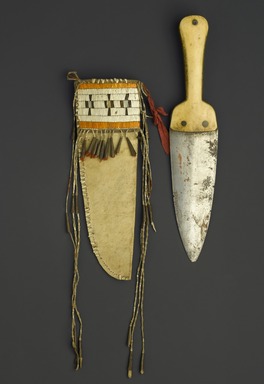
Artist:Eastern, Sioux
Medium: Steel, bone, hide, quills, copper, cloth
Geograhical Locations:
Dates:early 19th century
Dimensions: knife in sheath: 13 x 6 in. (33 x 15.2 cm) sheath including danglers: 13 3/4 × 4 × 1 in. (34.9 × 10.2 × 2.5 cm)
Collections:
Exhibitions:
Accession Number: 50.67.59a-b
Image: 50.67.59a-b_PS1.jpg,
Catalogue Description: The (steel?) knife blade (a) is known as a beaver tail stabber, Hudson's Bay dag or hand dag, with the later appellation appearing in trade accounts. It is a flat, triangular, spear shape joined to the handle with two copper rivets. The blade has no commercial markings. The handle is bone that is etched along the sides possibly with a tally of sorts made by the owner. The shape of the handle is nicely rounded at the grip to fit the palm comfortably and the butt acts as a guard to protect the hand from the blade. There is a third rivet at the end of the bone handle. The name "scalping" is probably inaccurate. The hide sheath (b) does not fit this dag knife and was probably made to fit a curved, commercial knife. The top edge of the sheath is decorated with a pattern of small quills. Threes crosses decorate a field of white quillwork on the panel. The cross at center is built around a light yellow square at center with dark brown arms. The two crosses on the right and left are pale blue squares at center with dark brown arms. On the edges of the panels, a small strip of red cloth, probably ribbon, is tied to the sheath's loop and two smaller loops with orange and white quillwork are attached. A border of tin cones stuffed with red dyed cloth is suspended from the panel. The streamers have remnants of wrappings with orange quillwork and decorated with additional cones. White quills along the seam and at the top of the knife sheath are applied as overcast stitches.